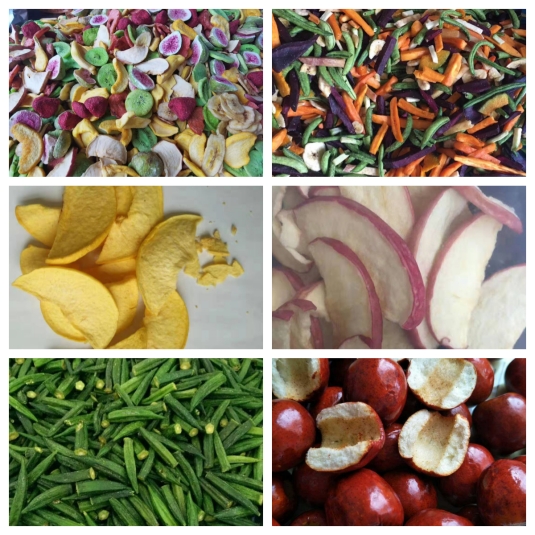Vacuum frying involves frying and dehydrating food at low temperatures (80~120°C), which can effectively reduce the damage to food nutrients caused by high temperatures.
1. The integrated design of heating, frying, oil storage, oil removal, dehydration and oil filtration is completed continuously under vacuum, and the product has low oil content. Generally, the oil content of fried food is as high as 40% to 50%, while the oil content of vacuum fried food is 10% to 20%, saving 30% to 40% of oil, and the oil saving effect is great. The food is crispy but not greasy, and has good storage properties.
2. Low-temperature vacuum frying can prevent edible oils from deteriorating and deteriorating. There is no need to add other antioxidants, which can improve the reuse rate of oil and reduce costs.
3. In the vacuum state, using oil as the heat transfer medium, the moisture inside the food (free water and partially bound water) will evaporate rapidly and eject, causing the tissue to form a loose and porous structure.
4. Automatically control temperature and pressure (vacuum degree) without overheating or overpressure to ensure product quality and safe production;
5. Deoiling adopts variable frequency speed regulation, which is suitable for all products with low and high oil content;
6. The oil-water separation system can cool and separate evaporated water and oil, reduce water circulation pollution, improve water reuse rate, and reduce oil loss;
7. Oil filtration system: upper and lower oil tanks, dual-chamber heating system, individually controlled heating, and circulating filtered oil during frying to keep the oil clean and reduce oil waste;
8. The machine is made of stainless steel materials and has the characteristics of high efficiency, stable performance, and easy installation and use.
Currently the main products processed
1. Vegetables: tomatoes, sweet potatoes, potatoes, green beans, shiitake mushrooms, mushrooms, garlic, carrots, green peppers, pumpkins, onions, etc.
2. Fruits: apples, kiwis, grapes, persimmons, strawberries, grapes, peaches, pears, etc.
3. Nuts: red dates, peanuts, etc.
4. Aquatic products, livestock and poultry meat, etc.
Sample:





